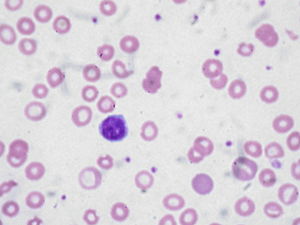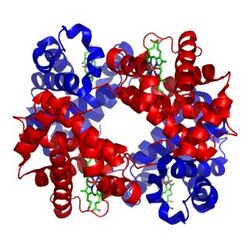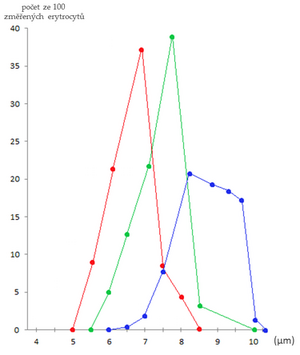Anemia from reduced erythrocyte production
Iron deficiency anemia - sideropenic anemia (microcytic, hypochromic)[edit | edit source]
| Siderocytes in blood smear | |
| Risk factors | malabsorption in celiac disease, Crohn's disease; chronic bleeding |
|---|---|
| Clinical picture | difficulty in swallowing, changes in nails, fatigue, neurological symptoms (e.g. paresthesia ) |
| Diagnostics | decreased plasma iron level, low serum ferritin , increased plasma transferrin , presence of siderocytes, anisocytosis, poikilocytosis |
| Therapy | supply of iron |
| Classification and references | |
Sideropenic anemia is caused by a disorder of hemoglobin synthesis due to iron deficiency. This is the most common anemia in children.
Causes of emergence[edit | edit source]
Insufficient supply of iron in food is rare in our country. Substances that inhibit resorption (phosphates, phytates) can cause reduced intake. It is more often manifested with malabsorption ( Celiac disease , Crohn's disease , after resection of the stomach or intestines). It also occurs with excessive blood loss during chronic bleeding ( peptic ulcers , hemorrhoids , GIT cancer , menorrhagia , metrorrhagia ). Iron deficiency also manifests itself if the organism has increased demands for hematopoiesis (during pregnancy, in childhood).
- Causes of sideropenic anemia in children
- Malabsorption - treatment with antacids, drugs that increase gastric pH, drinking tea and coffee.
- Insufficient/unavailable iron stores – bleeding, epistaxis , gastric and duodenal ulcers, Meckel's diverticulum , allergy to cow's milk protein , parasites, Helicobacter pylori infection , esophageal varices, tumors and polyps of the digestive system, inflammatory diseases of the GIT, AV malformation, diverticulitis, hemorrhoids, heavy menstrual bleeding, infections/tumors of the uropoietic tract, pulmonary hemosiderosis
- Congenital/acquired disorders of iron metabolism – atransferrinemia , disorders of heme synthesis .
Iron in the body[edit | edit source]
There are a total of 3-4 g of iron in the body , most of which is found in hemoglobin. By recycling iron from disintegrating erythrocytes, 20 mg is obtained per day, in an adult, <5% of iron comes from the diet, in an infant, 30%.
A full-term newborn has sufficient iron reserves for the first 6 months , after which a supply of iron through food is necessary. Premature babies have a lower hemoglobin concentration and lower iron reserves, therefore iron depletion already occurs around the 2nd month. Breast milk and cow's milk have the same iron content, but cow's milk is more difficult to absorb. The iron content in breast milk decreases after 5 months of breastfeeding. Boys need a higher supply of iron during puberty due to the increase in muscle mass and myoglobin. Girls need a higher iron intake due to losses during menstrual bleeding.
More detailed information can be found on the iron page .
Clinical picture and diagnosis[edit | edit source]
Microcytic hypochromic anemia . The erythrocyte volume distribution width (RDW) is usually increased due to anisocytosis. Thrombocytosis (500-700×10 9 /l) is relatively common.
- Prelatent sideropenia – deficiency of stored iron (reduced ferritin level , other values in the norm).
- Latent sideropenia – deficiency of stored and stored iron in macrophages. This leads to iron deficiency in erythropoiesis (decreased ferritin, iron and increased soluble transferrin receptor sTFR), without anemia.
- Sideropenic anemia – deficiency of stored and erythrocyte iron results in a drop in the level of hemoglobin, hematocrit, reduced mean erythrocyte volume (MCV), reduced hemoglobin content in erythrocyte (MCH). Furthermore, it is manifested by a low level of iron, ferritin and an increase in the total binding capacity by stimulating the production of transferrin in the liver and increasing sTFR. Transferrin saturation drops below 16%, hepcidin level drops .
There is a reduced amount of reticulocytes in the blood , more erythroblasts are found in the bone marrow . The marrow is normocellular, hypercellular in anemia due to increased losses. Depletion of stored iron is characteristic ( macrophages do not show hemosiderosis). It is mainly manifested by tissue hypoxia (eg tiger heart).
In children, it manifests itself most often between 6 months and 3 years of age and then in puberty. Iron deficiency during the child's growth period can lead to growth retardation, psychomotor development and cognitive function disorders (negative effect on learning to concentrate). Damage to the epithelium leads to atrophy of the papillae of the tongue and increased brittleness of the nails.
Differential diagnosis[edit | edit source]
- Anemia of inflammatory diseases – classically normocytic normochromic, in a third of patients microcytic hypochromic, but elevated ferritin and hepcidin.
- Thalassemia - microcytic hypochromic anemia, lower RDW, in the smear typical target-shaped erythrocytes and basophilic stippling of erythrocytes.
- Lead poisoning - microcytic/normocytic normochromic anemia; behavioral changes, convulsions, kidney damage, abdominal pain and vomiting.
- Sideroblastic anemia - hypochromic erythrocytes, increased serum iron, increased transferrin saturation, coronal sideroblasts in the bone marrow (the "coronas" are mitochondria overloaded with iron).
Therapy and prevention[edit | edit source]
Prevention is the addition of iron to infant formula, the introduction of meat and vegetable side dishes, cereals and milk products enriched with iron, the exclusion of non-adapted cow's milk from the infant diet and the prophylactic administration of iron in premature babies.
Substitution: oral preparations of iron (fasting) with simultaneous use of ascorbic acid , which increases iron resorption.
- Substitution preparations
- Divalent iron salts - ferrous sulfate (Aktiferrin, Ferronat);
- iron in a complex with polysaccharides (Maltofer) – fewer side effects;
- parenteral administration of trivalent Fe – in case of proven malabsorption, significant blood loss, noncompliance, etc.. Anemia is corrected as quickly as with oral substitution.
- Side effects
- Feeling of fullness, nausea, constipation or diarrhea. Acute iron poisoning manifests itself in severe gastrointestinal symptoms and systemic toxicity. As an antidote, we use deferoxamine , which binds toxic free iron.
The effect of the treatment is evaluated by the rise of reticulocytes (4th - 10th day of treatment), gradual rise of hemoglobin (by 20 g/L in 4 weeks). It usually takes a total of 3-5 months to continue to replenish iron stores.
Summary video[edit | edit source]
<mediaplayer width="500" height="300"> https://www.youtube.com/watch?v=WvD4p8FkQpY </mediaplayer>
Folic acid and vitamin B12 deficiency anemia[edit | edit source]
- Megaloblastic and macrocytic anemia.
- Folic acid (or its active form – tetrahydrofolate (THF) is necessary for DNA synthesis (and therefore also for cell division)).
- Vitamin B12 participates in the conversion of methyl-THF to THF with the simultaneous formation of methionine (important for the synthesis of choline) from homocysteine.
- Folic acid is mainly contained in vegetables , the deficiency begins to manifest itself after several weeks or months .
- The source of vitamin B12 is meat, dairy and egg products , the deficiency occurs only after several years .
- Folic acid deficiency affects:
- blood formation - insufficient formation of erythrocytes (megaloblastic and macrocytic anemia - predominates), platelets and granulocytes ;
- GIT mucosa – Hunter's glossitis, intestinal absorption disorders, diarrhea.
- Vitamin B12 deficiency affects:
- hematopoiesis and the GIT mucosa – as vitamin B12 is necessary for the proper function of folate, the lack of vitamin B12 can be replaced in this regard by administering folic acid.
- CNS - demyelination of axons, especially in the spinal cord (given by the lack of methionine, which is necessary for the synthesis of choline, a component of phospholipids of myelin sheaths), unlike anemia, which disappears after the restoration of the supply of vitamin B12, the neurological manifestations can be permanent;
- homocysteinemia – can lead to thrombosis .
Castle's anti-pernicious principle[edit | edit source]
- Intrinsic factor – a glycoprotein produced by the parietal cells of the gastric mucosa.
- External factor – vitamin B12.
- Vitamin B12 binds to intrinsic factor, creating a complex that is resistant to digestion and is resorbed in the ileum by enterocytes (they have specific receptors) - the cause of vitamin B12 deficiency is most often a lack of intrinsic factor (gastrectomy, antibodies against intrinsic factor or parietal cells of the gastric mucosa - gastritis A - chronic atrophic gastritis , affects the body and antrum of the stomach) or ileal disease (resection, inflammation, malabsorption , excessive consumption of vitamin B12 by multiplied intestinal bacteria - e.g. in the stump of the intestine after gastrectomy), infection with the tapeworm Diphyllobothrium latum .
- Vitamin B12 deficiency resulting from insufficient intake of vitamin B12 in food is the most frequently published problem of the vegan diet (the source of vitamin B12 is meat, eggs and dairy products - these foods are not consumed by vegans). Megaloblastic anemia from insufficient dietary intake of vitamin B12 is very common in developing countries where people have no money and therefore no access to animal foods (they become "unwanted vegans").
- Anemia resulting from an autoimmune process directed against the parietal cells of the gastric mucosa is referred to as pernicious anemia . Autoantibodies destroy parietal cells, the gastric mucosa atrophies, and achlorhydria occurs. All this leads to a decrease in the production of intrinsic factor, which is necessary for the absorption of vitamin B12 in the ileum. In addition to autoantibodies against parietal cells, autoantibodies are also produced that prevent the binding of vitamin B12 to intrinsic factor or prevent the binding of the vitamin B12–intrinsic factor complex to the receptor ensuring the absorption of this complex in the ileum.
- The administration of certain drugs (e.g. cytostatics methotrexate – inhibits its conversion into THF) leads to anemia due to folic acid deficiency .
- Bone marrow tends to be hypercellular .
- The cells of the marrow and in the peripheral blood are enlarged (prolonged maturation of their precursors – macrocytes, megaloblasts (large erythroblasts with an immature appearance of the nucleus)).
- There is more hemoglobin in enlarged erythrocytes (hyperchromic anemia).
- Large erythrocytes often die directly in the marrow without ever reaching the circulation (inefficient erythropoiesis) - hemolysis.
- RES macrophages are also increasingly destroyed.
- In the blood picture, in addition to the presence of macrocytes, a small content of reticulocytes and hypersegmentation of granulocyte nuclei are important.
Links[edit | edit source]
[edit | edit source]
Source[edit | edit source]
- PASTOR, Jan. Langenbeck's medical web page [online]. [feeling. 12/04/2010]. < https://langenbeck.webs.com/ >.
Reference[edit | edit source]
- ↑ a b c d e f g hJump up to: LEBL, J, J JANDA and P POHUNEK, et al. Clinical Pediatrics. 1st edition. Galén, 2012. 698 pp. pp. 538-540. ISBN 978-80-7262-772-1 .
- ↑ NEČAS, Emanuel, et al. Pathological Physiology of Organ Systems: Part I. 1st Edition. Prague: Karolinum, 2007. ISBN 978-80-246-0675-0 .
- ↑ ČESKA, Richard, et al. Internal 1st edition. Prague: Triton, 2010. 855 pp. ISBN 978-80-7387-423-0 .
- ↑ JIRÁSEK, Václav, Marie BRODANOVÁ and Zdeněk MAREČEK. Gastroenterology, Hepatology. 1st edition. Prague: Galén, 2002. ISBN 80-7262-139-4 .





